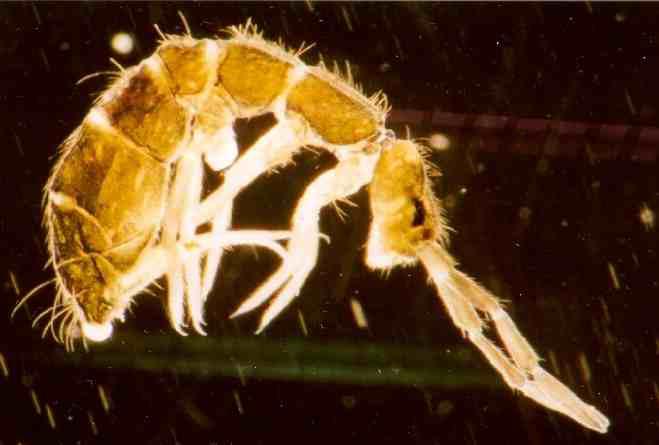Researcher studies tiny critters disappearing as quickly as they’re discovered
Springtails get their name from the tail-like structure that allows them to spring or jump. (Photo by U. Burkhardt via Wikimedia Commons.)
Usually it’s easy for Louis Deharveng to step outside onto the back doorstep of his lab in Paris, and find the tiny creatures he’s dedicated his life to studying.
But on one recent day, outside his lab at the National Museum of Natural History, after rooting around in a pile of leaves, there are none to be found.
Our whole web of life depends, ultimately, on the broad and amazing variety of organisms on this planet, including many science has yet to identify. Among those unrecorded millions of life forms are some that inhabit a peculiar branch of the evolutionary tree.
Deharveng studies collembola, better known as springtails, which until recently were classified as an insect. But additional research has reclassified them as their own type of creature.
That they can’t be found in the brush pile is no major event. It’s just too hot and dry. They’ll be back.
In Deharveng’s lab, he shows off an example of the species. It’s got six little legs, a pair of antennae, and it looks like a tiny shrimp or insect. A lot of them have a tail-like limb that allows them to spring.
“Many collembola have the jumping apparatus, and they can jump many times their own size. And they jump,” he said.
The feature, though, that really makes a collembola a collembola – is something called a ventral tube. A collembola uses its ventral tube to suck up water, and to attach itself to the ground.
Deharveng hasn’t always been a collembola devotee. When he began his studies as a scientist over 30 years ago, he wanted to focus on beetles. But he couldn’t find anyone who’d supervise a beetle project. So instead, he turned to a mentor who happened to have an interest in collembola.
And soon, because so little was known about them, he was hooked.
“It’s the pleasure to find new things outside in your environment,” he said. “We expect to find something but we don’t know what we shall find.”
Over the last several decades, scientists – including Deharveng – have continuously turned up new kinds of collembola. Right now, there are about 8,000 documented species, and there’s no sign of things leveling off.
Collembola are everywhere.
“They are able to adapt to any kind of habitats. They live from the tropics to the coldest place on Earth – they are in the Antarctic. From the deep caves to the canopy of the trees,” Deharveng said.
Deharveng’s traveled the world in search of collembola. He figures he’s named hundreds of species, and a handful of them have been named after him: Tetracanthella Deharvengi, Gnathisotoma Deharveng i, Paleonura louisi.
But Deharveng’s seen certain types of collembola fall on hard times. His early work focused on a group of species that used to thrive on a permanent patch of snow in the Pyrenees Mountains between Spain and France.
But as the temperature’s gotten warmer, the snow now melts in the summer.
“I was studying something disappearing under our eyes,” he said.
More recently, he’s investigated collembola species that live on a single limestone hill in Vietnam and nowhere else. Now that hill’s being blown apart to make concrete, and he’s worried these collembola may well be headed to extinction.
Wherever Deharveng travels, collembola are an important part of a tiny food web of insects and spiders. But he admits that most people have no reason to care about them.
“They are absolutely devoid of any economical interest,” he said.
Every day, reporters and producers at The World are hard at work bringing you human-centered news from across the globe. But we can’t do it without you. We need your support to ensure we can continue this work for another year.
Make a gift today, and you’ll help us unlock a matching gift of $67,000!
